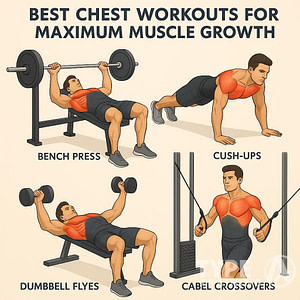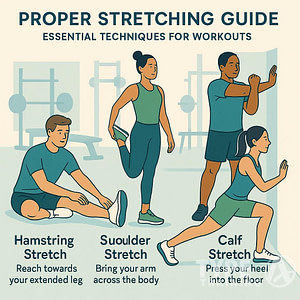Summer is a great time to get outside and enjoy the weather while working out. However, high temperatures and humidity can put a damper on your workout routine, causing you to feel sluggish and fatigued. It’s essential to adjust your summer workout routine to accommodate the summer heat and humidity to ensure that you’re getting the most out of your workout while staying safe.
To prevent dehydration and heat stroke when exercising in the summer, it’s crucial to be mindful of the signs. Opt for cooler times of the day such as early morning or late evening to work out. It’s also important to stay hydrated by drinking water before, during, and after exercise, regardless of your thirst level. Wearing loose-fitting, light-colored, and lightweight clothing can also help keep you cool while exercising.
Adjusting your workout routine for summer heat and humidity is crucial to maintain your workout performance. The heat and humidity can cause your body to work harder, making your workout more challenging than usual. By adjusting your Summer Workout Routine, you can avoid heat exhaustion, dehydration, and other heat-related illnesses while still getting the most out of your workout.
Key Takeaways
- Adjust your workout routine to accommodate the summer heat and humidity to ensure that you’re getting the most out of your workout while staying safe.
- Watch for signs of dehydration and heat stroke; choose a later evening or early morning time to exercise when the temperatures are cooler; drink plenty of water before, during, and after your workout; and wear lightweight, light-colored, and loose-fitting clothing to help keep you cool during your workout.
- Adjusting your workout routine for summer heat and humidity is crucial to maintain your workout performance while avoiding heat exhaustion, dehydration, and other heat-related illnesses.
Related: 8 Healthy Drink Alternatives to Water
Popular posts:
Best Time for Outdoor summer workout routine
Choosing the Best Time for Outdoor Workouts
Selecting the optimal time for outdoor workouts during summer is crucial to maximize performance and minimize risks associated with heat and humidity. The best times are typically early morning and late evening. Here’s why:
- Cooler Temperatures: The temperature is generally lower during these times, reducing the risk of heat-related illnesses.
- Lower Humidity Levels: Humidity often peaks in the afternoon, making early mornings and evenings more comfortable.
- Reduced Sun Exposure: The sun’s intensity is less severe, decreasing the chances of sunburn and heat exhaustion.
Benefits of Early Morning Workouts
Early morning workouts offer several advantages:
- Cooler Temperatures: Exercising in the morning helps avoid the peak heat of the day.
- Fewer Distractions: Fewer people and less noise can lead to a more focused and productive workout.
- Improved Sleep: Morning exercise can help regulate your sleep cycle, leading to better sleep quality.
- Boosted Energy Levels: Starting your day with a workout can increase your energy and mood for the rest of the day.
Benefits of Evening Workouts
Evening workouts also provide unique benefits:
- Stress Relief: Exercising after a long day can help reduce stress and unwind.
- Flexibility: More time to complete your workout without the rush of morning schedules.
- Enhanced Performance: Body temperature is slightly higher in the evening, which can improve muscle function and strength.
Comparison Table: Morning vs. Evening Workouts
| Aspect | Morning Workouts | Evening Workouts |
|---|---|---|
| Temperature | Cooler | Warm but cooling down |
| Distractions | Fewer | Moderate |
| Sleep Impact | Improves sleep quality | Can interfere with sleep if too late |
| Energy Levels | Boosts morning energy | Relieves stress and tension |
Pro Tip: Regardless of the time you choose, always listen to your body. Stay hydrated, wear appropriate clothing, and take breaks as needed to ensure a safe and effective workout.
By carefully choosing the time of day for your workouts and understanding the benefits of both morning and evening sessions, you can optimize your summer exercise routine for better performance and safety.
Importance of Adjusting Your Workout Routine
Summer is a great time to get outside and enjoy the warm weather, but it’s important to adjust your workout routine to stay safe and healthy in the heat and humidity. In this section, we’ll discuss the impact of heat and humidity on your body and the benefits of adjusting your workout routine for summer.
Source: weather.gov
Impact of Heat and Humidity on Your Body
Exercising in the heat and humidity can put a lot of stress on your body, especially if you’re not used to it. Your body’s cooling system has to work harder to maintain a safe core body temperature, which can lead to dehydration, heat exhaustion, and even heat stroke. It’s important to pay attention to your body’s signals and take breaks or seek medical attention if you start to feel overheated or fatigued.
According to Dr. Cedric X. Bryant, President and Chief Science Officer of the American Council on Exercise, “The combination of heat and humidity can make it difficult for sweat to evaporate, which can lead to an increase in core body temperature. This can negatively impact your workout performance and increase your risk of heat-related illnesses.”
Benefits of Adjusting Your Workout Routine for Summer
Adjusting your workout routine for summer can help you stay safe and healthy while still achieving your fitness goals. Here are some benefits of making these adjustments:
- Improved performance: By adjusting your workout intensity and timing, you can improve your performance in the heat and humidity. For example, you may want to schedule your workouts for the morning or evening when it’s cooler, or switch to swimming or other water-based activities to stay cool.
- Reduced risk of heat-related illnesses: By staying hydrated, wearing sunscreen and appropriate clothing, and taking breaks in the shade, you can reduce your risk of heat exhaustion, heat stroke, and other heat-related illnesses.
- Faster recovery: By incorporating a cool down and recovery routine into your workouts, you can help your body recover more quickly from the stress of exercising in the heat and humidity.
- Overall safety: By following safety measures such as staying hydrated, adjusting your workout location and gear, and listening to your body’s signals, you can stay safe and healthy while still enjoying the outdoors.
Remember, it’s important to consult with a specialist or your doctor before starting a new exercise routine, especially if you have any chronic diseases such as cardiovascular disease or diabetes.
“Hydration is key during hot weather workouts. Make sure to drink plenty of water before, during, and after your workout to avoid dehydration.” – Dr. Cedric X. Bryant, President and Chief Science Officer of the American Council on Exercise.
Selecting the Right and Clothing
Choosing the right gear and clothing for summer workouts is essential to stay comfortable, safe, and perform at your best. Here’s a detailed guide on recommended clothing materials and the importance of sun protection.
Recommended Clothing Materials for Hot Weather
Wearing the right materials can make a significant difference in how you feel during your workout. Here are some top choices:
- Lightweight Fabrics: Opt for materials like cotton or linen that are light and breathable.
- Moisture-Wicking Fabrics: Fabrics such as polyester and nylon help wick away sweat, keeping you dry and comfortable.
- Mesh Panels: Clothing with mesh panels allows for better airflow and ventilation.
- Loose-Fitting Clothes: Loose clothing helps air circulate around your body, reducing the risk of overheating.
Examples of Suitable Fabrics
| Fabric Type | Benefits |
|---|---|
| Cotton | Breathable, soft, and comfortable |
| Polyester | Moisture-wicking, quick-drying |
| Nylon | Durable, moisture-wicking, lightweight |
| Linen | Highly breathable, cool, and light |
Importance of Sun Protection
Protecting your skin from harmful UV rays is crucial when exercising outdoors. Here are key strategies:
- Wear Sunscreen: Apply a broad-spectrum sunscreen with at least SPF 30. Reapply every two hours, or more often if sweating heavily.
- Use a Hat: A wide-brimmed hat can shield your face, ears, and neck from the sun.
- Sunglasses: Protect your eyes with UV-blocking sunglasses.
- Clothing with UPF: Choose clothing with an Ultraviolet Protection Factor (UPF) rating for additional sun defense.
Sun Protection Tips
- Seek Shade: Whenever possible, choose shaded areas for your workouts.
- Avoid Peak Sun Hours: Try to exercise early in the morning or late in the evening when the sun’s rays are less intense.
- Stay Hydrated: Drink plenty of water to help your body regulate temperature and stay hydrated.
Pro Tip: Look for clothing labeled with UPF ratings, which indicate the level of UV protection provided by the fabric.
By selecting the right gear and clothing, you can significantly enhance your comfort and safety during summer workouts. Remember to prioritize breathable materials and sun protection to keep your body cool and protected from harmful UV rays.
Indoor Alternatives for High-Temperature Days
When the summer heat becomes unbearable, shifting your workouts indoors can be a smart and effective alternative. Here’s a comprehensive guide on effective indoor workouts, the benefits of air-conditioned environments, and the advantages of interval training.
Effective Indoor Workouts
Indoor workouts can be just as effective as outdoor ones, offering variety and convenience. Here are some great options:
- Bodyweight Exercises: Push-ups, squats, lunges, and planks can be done anywhere and require no equipment.
- Yoga and Pilates: These practices improve flexibility, strength, and mental focus.
- Cardio Workouts: Jump rope, high knees, and stair climbing are excellent for cardiovascular health.
- Strength Training: Use dumbbells, resistance bands, or kettlebells for muscle building.
Sample Workout Routine
| Exercise | Duration | Repetitions |
|---|---|---|
| Jump Rope | 5 minutes | – |
| Push-Ups | – | 3 sets of 15 |
| Squats | – | 3 sets of 20 |
| Plank | 1 minute hold | – |
| Yoga Stretch | 10 minutes | – |
Benefits of Air-Conditioned Environments
Exercising in an air-conditioned environment offers several advantages:
- Temperature Control: Keeps your body temperature regulated, reducing the risk of heat-related illnesses.
- Improved Air Quality: Filters out pollutants and allergens, providing a cleaner breathing environment.
- Comfort: Makes workouts more pleasant, encouraging consistency and longer exercise sessions.
Pro Tip: Always stay hydrated, even when working out indoors, as air conditioning can sometimes lead to dehydration.
Interval Training
Interval training is a highly effective indoor workout method that alternates between periods of high-intensity exercise and low-intensity recovery. Benefits include:
- Increased Caloric Burn: Burns more calories in a shorter amount of time.
- Improved Cardiovascular Health: Enhances heart and lung function.
- Efficiency: Short, intense workouts fit easily into busy schedules.
Sample Interval Training Routine
| Exercise | High Intensity | Low Intensity |
|---|---|---|
| Jumping Jacks | 1 minute | 30 seconds rest |
| Burpees | 1 minute | 30 seconds rest |
| High Knees | 1 minute | 30 seconds rest |
| Mountain Climbers | 1 minute | 30 seconds rest |
Pro Tip: For more detailed interval training routines, check out this guide on interval training.
By incorporating these indoor alternatives, you can maintain an effective workout routine regardless of the outdoor temperature. Prioritize comfort and efficiency with air-conditioned environments and interval training to stay fit and healthy all summer long.
Related: HIIT Workouts: Maximize Fitness in Less Time
The Impact of Air Quality on a Summer Workout Routine
Explanation of How Air Quality Affects Exercise Performance
When the air quality is poor, it can affect your workout performance. Air pollution can reduce the amount of oxygen that you take in while exercising, which can lead to fatigue and shortness of breath. This can make your workout feel more challenging than it actually is, and it can also reduce the amount of time that you are able to exercise.
Discussion of the Negative Health Effects of Poor Air Quality
Poor air quality can have negative health effects on your body, especially if you are exercising outdoors. Air pollution can irritate your lungs and cause inflammation, which can lead to respiratory problems. It can also increase your risk of developing heart disease and stroke.
According to Dr. Susan Laubach, a pulmonologist at the University of Virginia Health System, “Air pollution can be especially harmful to people with underlying lung or heart disease, as well as young children and older adults. It’s important to pay attention to air quality alerts and take steps to protect yourself when the air quality is poor.”
Strategies for Protecting Yourself During Poor Air Quality
If you are planning to exercise outdoors during the summer, it’s important to pay attention to the air quality index (AQI) in your area. The AQI is a measure of how polluted the air is, and it can range from 0 to 500. The higher the AQI, the more polluted the air is, and the greater the health risks.
Here are some strategies for protecting yourself during poor air quality:
- Check the AQI before you exercise. If the AQI is above 100, consider exercising indoors or postponing your workout until the air quality improves.
- Exercise during off-peak hours when the air quality is likely to be better, such as early in the morning or late in the evening.
- Wear a mask or face covering to reduce your exposure to air pollution.
- Choose low-intensity workouts that don’t require heavy breathing, such as yoga or walking.
- Stay hydrated to help flush out any toxins that you may have breathed in.
Remember, your health should always be a top priority. Don’t push yourself too hard if the air quality is poor, and always listen to your body.
In the words of Dr. Laubach, “It’s important to be aware of the air quality in your area and take steps to protect yourself, especially if you have underlying health conditions. By being proactive and taking the necessary precautions, you can still enjoy outdoor exercise during the summer months.”
Sources:
- How Air Pollution Affects Your Workout
- Air Quality and Exercise: What You Need to Know
The Benefits of Early Morning Workouts in the Summer
When summer heat and humidity make it difficult to exercise, consider shifting your workout routine to the early morning. Here are some benefits of morning workouts in the summer:
1. Cooler Temperatures
Early morning temperatures are typically cooler than later in the day, making it easier to exercise in the summer heat. According to NPR, “The optimal time to exercise in the summer is before 10 a.m. or after 6 p.m. when temperatures are cooler.”
2. Fewer Distractions
Morning workouts can also help you avoid distractions that can interfere with your exercise routine. According to Healthline, “Morning workouts typically mean you’re less prone to interruptions and distractions, such as work, family, or unexpected events.”
3. Improved Sleep
Research shows that morning workouts can help improve sleep quality. According to the UHealth Collective, “If you start your day with a good expenditure of energy, it seems to increase melatonin levels later in the day.”
4. Boosted Energy
Working out in the morning can help boost your energy levels for the rest of the day. According to Verywell Fit, “Cashing in on those [health benefits] is a matter of getting in a workout on a regular basis. Even though there’s no difference in results for workout timing, the benefits of working out in the morning are an added bonus.”
In summary, morning workouts in the summer can help you exercise more comfortably, avoid distractions, improve sleep quality, and boost your energy levels. As Dr. Henry says, “If you start your day with a good expenditure of energy, it seems to increase melatonin levels later in the day.”
Nutrition Tips for Summer Workouts
Proper nutrition is crucial for maximizing your performance and recovery during summer workouts. Here’s a comprehensive guide on what to eat before and after workouts and the importance of electrolytes.
Foods to Eat Before Workouts
Eating the right foods before a workout can provide the energy you need to perform at your best. Here are some recommendations:
- Complex Carbohydrates: Oats, whole grain bread, and brown rice provide sustained energy.
- Lean Proteins: Chicken, turkey, and Greek yogurt help build and repair muscles.
- Fruits: Bananas, apples, and berries offer quick energy and essential vitamins.
Pre-Workout Snack Ideas
| Snack | Benefits |
|---|---|
| Banana with Peanut Butter | Quick energy and protein |
| Greek Yogurt with Berries | Protein and antioxidants |
| Whole Grain Toast with Avocado | Healthy fats and complex carbs |
Foods to Eat After Workouts
Post-workout nutrition is essential for recovery and muscle building. Focus on:
- Proteins: Eggs, fish, and protein shakes to repair muscles.
- Carbohydrates: Sweet potatoes, quinoa, and fruits to replenish glycogen stores.
- Healthy Fats: Nuts, seeds, and avocados for overall health.
Post-Workout Snack Ideas
| Snack | Benefits |
|---|---|
| Protein Shake with Banana | Quick protein and carbs |
| Grilled Chicken with Quinoa | Balanced meal with protein and carbs |
| Cottage Cheese with Pineapple | Protein and natural sugars |
Importance of Electrolytes
Electrolytes are minerals that help maintain fluid balance, muscle function, and nerve signaling. During intense summer workouts, you lose electrolytes through sweat, making it essential to replenish them.
Key Electrolytes
- Sodium: Maintains fluid balance and prevents cramps.
- Potassium: Supports muscle function and prevents cramps.
- Magnesium: Aids in muscle relaxation and energy production.
- Calcium: Essential for muscle contractions and bone health.
Electrolyte-Rich Foods
| Food | Electrolyte |
|---|---|
| Bananas | Potassium |
| Spinach | Magnesium |
| Dairy Products | Calcium |
| Nuts and Seeds | Magnesium and Calcium |
Pro Tip: Consider drinking electrolyte-enhanced beverages or coconut water to quickly replenish lost electrolytes during and after workouts.
Hydration Tips
- Drink Water Regularly: Aim for at least 8 cups of water daily, more if you’re sweating heavily.
- Include Electrolyte Drinks: Especially after long or intense workouts.
- Monitor Urine Color: Light yellow indicates proper hydration; dark yellow suggests you need more fluids.
For more detailed nutrition tips and guidance, check out this comprehensive guide on summer workout nutrition.
By following these nutrition tips, you can ensure your body is well-fueled and hydrated, helping you to perform at your best and recover efficiently during the hot summer months.
Conclusion
Adapting your workout routine for summer’s heat and humidity is essential for maintaining performance and safety. Here’s a summary of the key strategies discussed:
Timing:
- Early Morning Workouts: Cooler temperatures and fewer distractions.
- Evening Workouts: Stress relief and enhanced performance due to slightly higher body temperature.
Gear and Clothing:
- Lightweight, Breathable Fabrics: Cotton, polyester, and linen.
- Sun Protection: Sunscreen, hats, sunglasses, and UPF-rated clothing.
Indoor Alternatives:
- Effective Indoor Workouts: Bodyweight exercises, yoga, cardio, and strength training.
- Benefits of Air-Conditioned Environments: Temperature control, improved air quality, and comfort.
- Interval Training: Increased caloric burn and improved cardiovascular health.
Nutrition and Hydration:
- Pre-Workout Foods: Complex carbs, lean proteins, and fruits.
- Post-Workout Foods: Proteins, carbohydrates, and healthy fats.
- Electrolytes: Importance of sodium, potassium, magnesium, and calcium.
Pro Tip: Always listen to your body and make necessary adjustments. Stay hydrated and take breaks as needed.
By implementing these strategies, you can ensure a safe, effective, and enjoyable workout routine throughout the summer. For more detailed tips and guidance, visit this Type A Training..
Stay proactive about your health and fitness, and enjoy the benefits of a well-adjusted summer workout regimen.
FAQ about Your Summer Workout Routine
What are some tips for exercising in hot and humid conditions?
When exercising in hot and humid conditions, it’s important to take extra precautions to avoid heat-related illnesses such as heat exhaustion or heat stroke. Some tips to keep in mind include staying hydrated by drinking plenty of water before, during, and after exercise, wearing lightweight and breathable clothing, and exercising during the cooler parts of the day, such as early morning or late evening. Additionally, it’s important to listen to your body and take breaks when needed to prevent overexertion.
How does humidity affect exercise performance?
Humidity can make it more difficult to exercise by causing your body to work harder to regulate its internal temperature. This can lead to increased heart rate, decreased endurance, and a higher risk of heat-related illnesses. However, some studies have shown that exercising in humidity can improve your body’s ability to regulate its internal temperature and may lead to improved performance over time.
“Training in the heat and humidity can improve your body’s ability to thermoregulate, or maintain a stable internal temperature, which can ultimately lead to improved exercise performance.” – Dr. Matt Leonard, attending emergency physician at Suburban Hospital in Bethesda, Maryland.
What are the benefits of working out in humidity?
Exercising in humidity can have several benefits, including improved thermoregulation, increased sweat production, and improved cardiovascular fitness. Additionally, some studies have shown that exercising in humidity can lead to increased calorie burn and may help improve athletic performance in certain conditions.
What are some ways to manage heat when exercising in summer?
To manage heat when exercising in summer, it’s important to take several precautions. These include staying hydrated by drinking plenty of water, wearing lightweight and breathable clothing, taking breaks when needed, and exercising during the cooler parts of the day. Additionally, it’s important to listen to your body and not push yourself too hard, as this can lead to heat-related illnesses.
When is it too humid to exercise?
There’s no set humidity level at which it becomes too humid to exercise, as this can vary depending on factors such as air temperature, wind speed, and your individual tolerance for humidity. However, it’s important to pay attention to your body and take breaks as needed to prevent overexertion and heat-related illnesses.
How can you adjust your workout routine for summer heat and humidity?
To adjust your workout routine for summer heat and humidity, consider exercising during the cooler parts of the day, such as early morning or late evening, wearing lightweight and breathable clothing, and taking more frequent breaks. Additionally, you may want to adjust the intensity of your workouts to account for the extra stress on your body caused by the heat and humidity.








